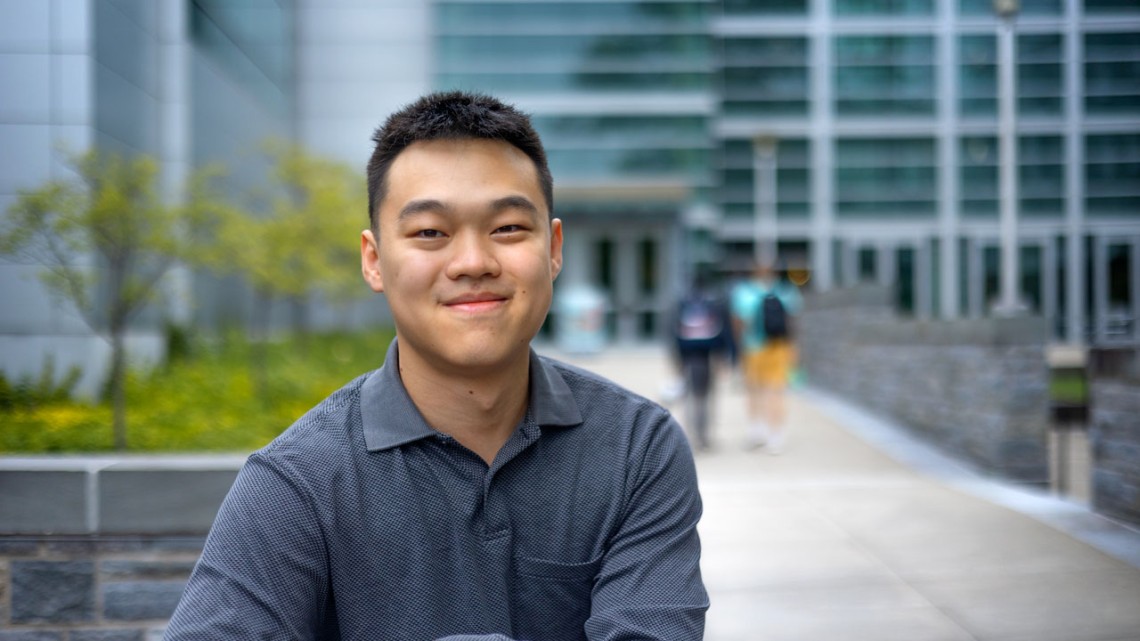
Rocky An ’23 is a biological and mechanical engineering double major in the College of Engineering.
Undergrad publishes theory on immune dysfunction in space
By Caitlin Hayes, Cornell Chronicle
It’s been known for decades that astronauts’ immune systems become suppressed in space, leaving them vulnerable to disease, but the exact mechanisms of immune dysfunction have remained a mystery – now a Cornell undergraduate has found a potential solution.
A biological and mechanical engineering double major in the College of Engineering, Rocky An ’23 published his theory, “MRTF May be the Missing Link in a Multiscale Mechanobiology Approach toward Macrophage Dysfunction in Space,” Sept. 12 in Frontiers in Cell and Developmental Biology.
An reviewed the last 20 years of literature on the behavior of macrophages – key cells in the body’s immune response – in space and recent research about how macrophages respond to forces in normal gravity, identifying a transcription factor that could prove to be the missing piece of the puzzle.
“I just kept asking questions about how the data is presented,” An said. “There are these two really important papers, in particular, one a review of how macrophages are suppressed in microgravity, and another about the mechanobiology of macrophages. I was able to connect these two papers, and that's when the idea came to me. I was really excited, as it was kind of a eureka moment for me.”
In space, the lack of gravity changes the shape of the immune cell, and scientists have suspected that changes to the cytoskeleton, the filamented infrastructure of the cell, were involved in immune dysfunction. Recent studies in normal gravity have shown that disturbing the cytoskeleton of macrophages reduces the transport of a particular protein, a transcription factor important for immune response, to the nucleus.
By comparing the studies of cells in microgravity and analyzing the modes of study and associated timescales – whether macrophages were actually studied in space, or on a parabolic airplane, or in a simulation of microgravity in the lab – An was able to point to this protein, Myocardin-Related Transcription Factor (MRTF), as a probable culprit in immune system dysfunction.
“I think it’s a pretty convincing argument that MRTF is a big part of the problem,” An said. “I hope it will inspire future studies that really focus on that one protein and the cytoskeleton, and maybe it could be the first step towards a spaceflight immune treatment.”
The paper suggests that MRTF could be implicated in the stress on the cardiovascular health of astronauts as well. An also points to other factors that may play a role in immune dysfunction and notes that further research is needed to understand how MRTF interacts with the macrophage nucleus in microgravity.
While An worked independently on the publication, he credits his Cornell professors (including Mingming Wu, professor, and Minglin Ma, associate professor, both of biological and environmental engineering in the College of Agriculture and Life Sciences; Brian J. Kirby, the Meinig Family Professor of Engineering; and Donna Cassidy Hanley, senior research associate in the College of Veterinary Medicine, among many other teachers) for modeling an interdisciplinary approach and encouraging inquiry.
Even before enrolling at Cornell, An had contact with the lab of Theodore Clark, professor of microbiology and immunology in the College of Veterinary Medicine, where An has engaged in research since his freshman year. He also credits his experience on the Cornell iGEM (Genetically Engineered Machines) Project Team, with advising from Jan Lammerding, professor in the Meinig School of Biomedical Engineering, as helping him develop as a scientist.
“The biggest help has been the professors and the way they’ve taught my classes,” An said. “And then with research in the lab and my project team, there have been a lot of opportunities to learn independently and ask our own questions.”
An also gained valuable experience in summer internships. In 2021, he was chosen as a research associate for NASA’s Space Life Sciences Training Program, where he studied the impact of microgravity on cells and co-authored his first paper, an optimization of a modeling framework for studying cells in microgravity.
An then spent the summer of 2022 as an Amgen Scholar at Harvard University’s Wyss Institute, where he worked in the area of mechanical immunotherapy, exploring therapies that work by manipulating cells’ structure.
“I’ve always been interested in cells, but also the mechanics, how cells react to forces,” An said. “I like this approach because it’s somewhat new, and I think it's very different from what you generally learn in biology, where everything's a series of chemical reactions. I really enjoy the interaction between the two fields.”
Support for An’s publication came from the Cornell Open Access Publication Fund.
Media Contact
Get Cornell news delivered right to your inbox.
Subscribe
